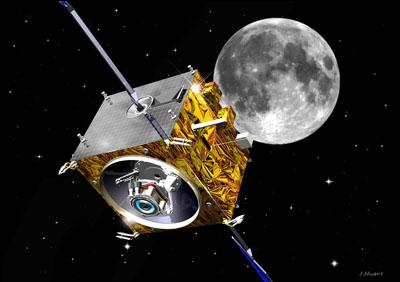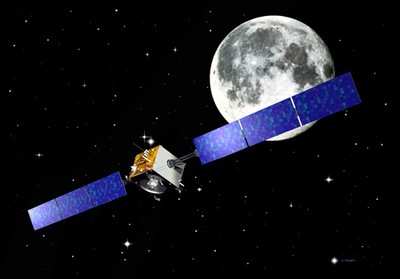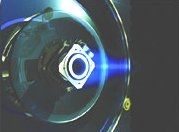"New And Unique" Spacecraft Sets Standard For Future
Probes
The European Space Agency says it learned many things from the
recently-concluded SMART-1 mission to the moon; in fact, you could
say the agency is now a little SMARTer.

ANN apologizes for the pun, and the editor responsible has been
punished accordingly... but in his defense, the ESA acknowledged
the same thing. From the probe's unique mission profile, to the new
technologies successfully tested... the SMART-1 gave engineers and
scientists with the ESA several things to think about. A few months
after the end of the mission, scientists and engineers gathered to
recap on these and all the other achievements of the first European
mission to the Moon.
ESA representatives stated the innovative SMART-1 Moon mission
taught ESA, the European space industry and other institutes a lot
about how to perform its missions even more efficiently. For
example, the operational tools developed and the lessons learned
are already being used on ESA missions such as Rosetta and Venus
Express. The SMART-1 experience has also been used to prepare
future ESA missions, such as Bepi-Colombo, which will visit the
inner planet Mercury.
On January 16-17, engineers and scientists met at ESA's space
technology center (ESTEC) in the Netherlands, to discuss the
success of SMART-1 and how to apply the achievements to current and
future missions.
"SMART-1 proved that, with a sense of innovation and commitment,
Europe can perform highly complex missions efficiently," says
Bernard Foing, SMART-1's project scientist. "From the start it was
designed to both test new technologies and perform useful
science."

Ten years ago, Foing began designing the mission with Giuseppe
Racca, SMART-1's Project Manager. "SMART-1 was new and unique. We
demonstrated innovative technologies for spacecraft and
instruments," says Racca.
Perhaps the most obvious new technology was the way SMART-1
traveled to the Moon. SMART-1's electric propulsion system (below,
right) applied a small thrust over a long period. Although this
meant SMART-1 took 13.5 months to reach the Moon, plus an extra 4
months to reach its working science orbit, for deep space missions
electric propulsion is more efficient than traditional rockets, in
terms of flight time.
"SMART-1 will open the door for new missions because electric
propulsion makes it possible to transport more instruments, with
lower propellant mass, on affordable rockets with more flexible
launch and navigation constraints, in shorter periods of time,"
says Giorgio Saccoccia, ESA's Head of Propulsion Division.
 Using electric propulsion,
ESA can send Bepi-Colombo to Mercury in just six years, whereas
traditional rockets would take at least seven. Electric propulsion
will also be able to transport much more scientific equipment to
Mercury than a traditional spacecraft. "With SMART-1, we learned
how to drive an electric propulsion spacecraft," says Foing.
Using electric propulsion,
ESA can send Bepi-Colombo to Mercury in just six years, whereas
traditional rockets would take at least seven. Electric propulsion
will also be able to transport much more scientific equipment to
Mercury than a traditional spacecraft. "With SMART-1, we learned
how to drive an electric propulsion spacecraft," says Foing.
"With SMART-1 some dreams became reality. Budget and time
pressure originated innovation in spite of the low cost of the
mission", says Octavio Camino, Smart-1 Operations Manager at ESOC,
"SMART-1 allowed us to test new concepts relevant for future ESA
infrastructure for operations automation".
The SMART-1 team also found out how to squeeze the most out of
scientific instruments. Originally, the team had planned to take
four images per 14.5-hour orbit with the SMART-1 camera, AMIE. As
the mission progressed, the team lowered the orbit of SMART-1, so
that it circled the Moon in just five hours.
This meant that they had to reprogram the camera to work much
faster, as the lunar surface was now rushing by below. In the end,
AMIE was supplying 100 images per orbit. The software tools they
developed, to schedule this massive upgrade in usage, are now being
employed on Venus Express and Rosetta.
The flood of image data has allowed the teams to construct
highly detailed maps of the lunar surface. "We have already used
the maps to identify possible landing sites for future landers,
rovers and even manned bases," says Foing.
Even the instruments on SMART-1 were special. They were
miniaturized to be ten times lighter than their traditional
counterparts. The camera weighed just 2 kilograms. As a result, two
of the instruments (D-CIXS and SIR), which mapped the Moon's
elemental composition and minerals, are being upgraded and rebuilt
to fly on the 2008 Indian Moon mission Chandrayaan-1.
While the SMART-1 mission is over, Foing thinks there is no room
for complacency. He describes the mission as 'a bridge to the
future' and says, "We cannot rest on our laurels. By analyzing data
and lessons learned, we have to carry the SMART-1 legacy
forward."
 ANN's Daily Aero-Linx (04.16.24)
ANN's Daily Aero-Linx (04.16.24) Aero-News: Quote of the Day (04.16.24)
Aero-News: Quote of the Day (04.16.24) Airborne 04.10.24: SnF24!, A50 Heritage Reveal, HeliCycle!, Montaer MC-01
Airborne 04.10.24: SnF24!, A50 Heritage Reveal, HeliCycle!, Montaer MC-01 Airborne 04.12.24: SnF24!, G100UL Is Here, Holy Micro, Plane Tags
Airborne 04.12.24: SnF24!, G100UL Is Here, Holy Micro, Plane Tags Airborne-Flight Training 04.17.24: Feds Need Controllers, Spirit Delay, Redbird
Airborne-Flight Training 04.17.24: Feds Need Controllers, Spirit Delay, Redbird





